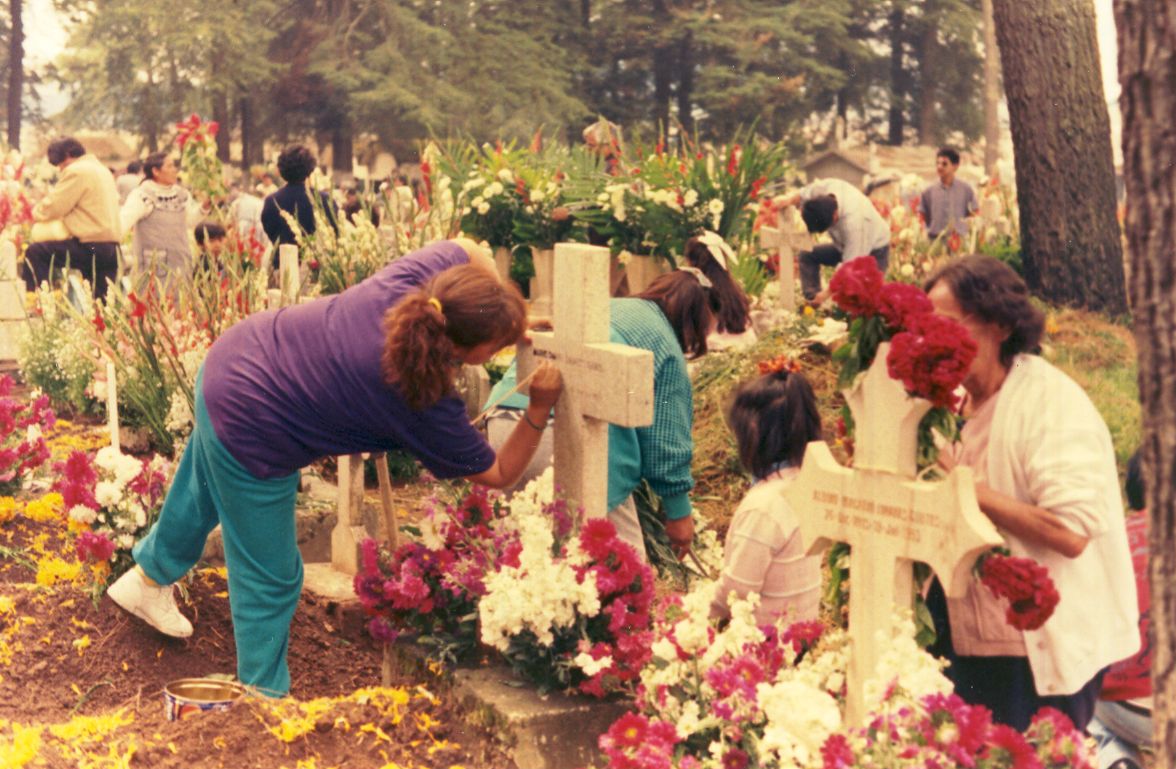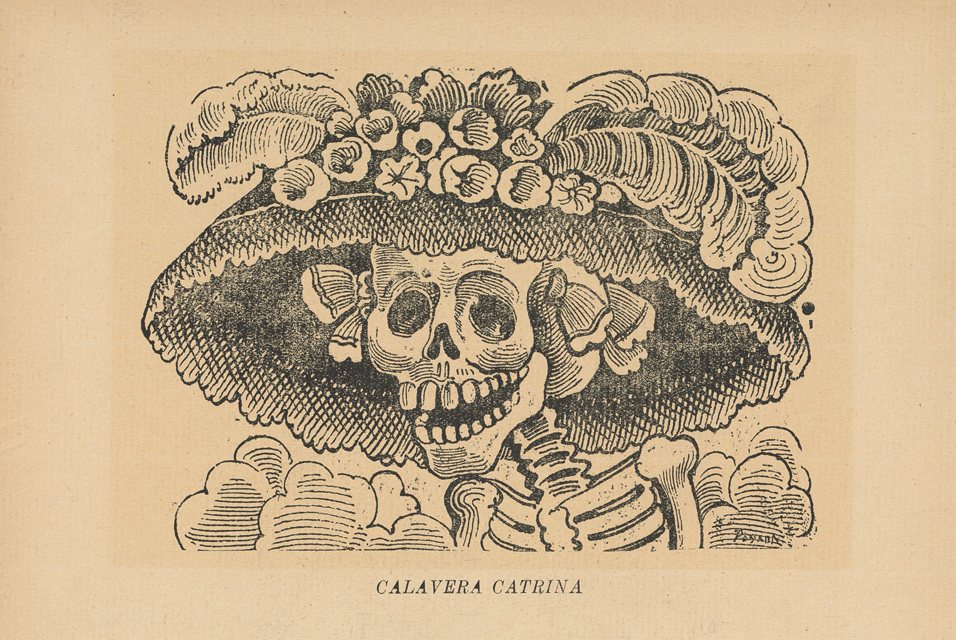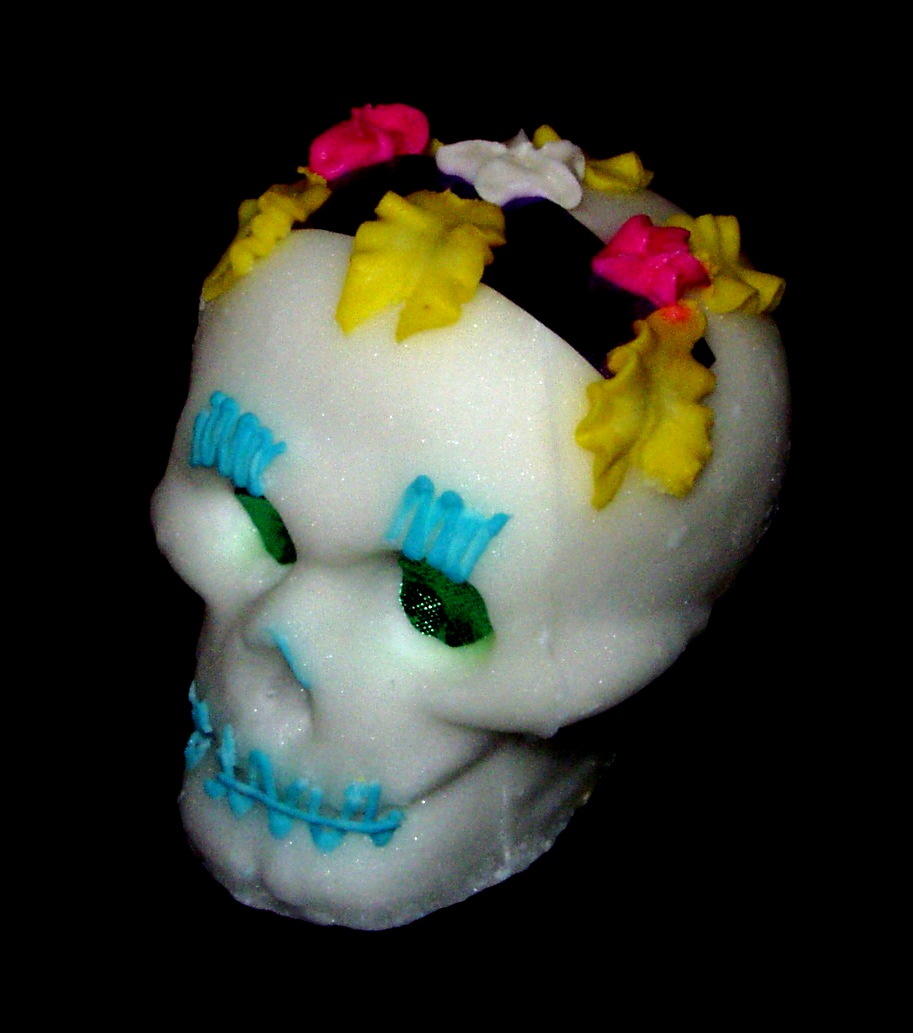|
Calaca
A calaca (, a colloquial Mexican Spanish name for skeleton) is a figure of a skull or skeleton (usually human) commonly used for decoration during the Mexican Day of the Dead festival, although they are made all year round. Description Tracing their origins from Mayan imagery, calacas are frequently shown with marigold flowers and foliage. As with other aspects of the Day of the Dead festival, calacas are generally depicted as joyous rather than mournful figures. They are often shown wearing festive clothing, dancing, and playing musical instruments to indicate a happy afterlife. This draws on the Mexican belief that no dead soul likes to be thought of sadly, and that death should be a joyous occasion. This goes back to Aztec beliefs, one of the few calaca to remain after the Spanish conquest. Calacas used in the festival include carved skull masks worn by revelers, small figures made out of carved wood or fired clay, and sweet treats in the form of skulls or skeletons. Calacas ... [...More Info...] [...Related Items...] OR: [Wikipedia] [Google] [Baidu] |
Grim Fandango
''Grim Fandango'' is a 1998 adventure game directed by Tim Schafer and developed and published by LucasArts for Microsoft Windows. It is the first adventure game by LucasArts to use 3D computer graphics overlaid on pre-rendered static backgrounds. As with other LucasArts adventure games, the player must converse with characters and examine, collect, and use objects to solve puzzles. ''Grim Fandango'' is set in the Land of the Dead, through which recently departed souls, represented as ''calaca''-like figures, travel before they reach their final destination. The story follows travel agent Manuel "Manny" Calavera as he attempts to save new arrival Mercedes "Meche" Colomar, a virtuous soul, on her journey. The game combines elements of the Aztec afterlife with ''film noir'' style, with influences including '' The Maltese Falcon'', '' On the Waterfront'' and ''Casablanca''. ''Grim Fandango'' received praise for its art design and direction. It was selected for several awards and i ... [...More Info...] [...Related Items...] OR: [Wikipedia] [Google] [Baidu] |
Day Of The Dead
The Day of the Dead ( es, Día de Muertos or ''Día de los Muertos'') is a holiday traditionally celebrated on November 1 and 2, though other days, such as October 31 or November 6, may be included depending on the locality. It is widely observed in Mexico, where it largely developed, and is also observed in other places, especially by people of Mexican heritage. Although related to the simultaneous Christian remembrances for Hallowtide, it has a much less solemn tone and is portrayed as a holiday of joyful celebration rather than mourning. The multi-day holiday involves family and friends gathering to pay respects and to remember friends and family members who have died. These celebrations can take a humorous tone, as celebrants remember funny events and anecdotes about the departed. Traditions connected with the holiday include honoring the deceased using calaveras and marigold flowers known as ''cempazúchitl'', building home altars called '' ofrendas'' with the favorite fo ... [...More Info...] [...Related Items...] OR: [Wikipedia] [Google] [Baidu] |
Skeleton (undead)
A skeleton is a type of physically manifested undead often found in fantasy, gothic and horror fiction, and mythical art. Most are human skeletons, but they can also be from any creature or race found on Earth or in the fantasy world. Myth and folklore Animated human skeletons have been used as a personification of death in Western culture since the Middle Ages, a personification perhaps influenced by the valley of the dry bones in the Book of Ezekiel. The Grim Reaper is often depicted as a hooded skeleton holding a scythe (and occasionally an hourglass), which has been attributed to Hans Holbein the Younger (1538). Death as one of the biblical horsemen of the Apocalypse has been depicted as a skeleton riding a horse. ''The Triumph of Death'' is a 1562 painting by Pieter Bruegel the Elder depicting an army of skeletons raiding a town and slaughtering its occupants. " The Boy Who Wanted the Willies" is a Brothers Grimm fairy tale in which a boy named Hans joins a circle of danc ... [...More Info...] [...Related Items...] OR: [Wikipedia] [Google] [Baidu] |
Coco (2017 Film)
''Coco'' is a 2017 American computer-animated fantasy film produced by Pixar Animation Studios and released by Walt Disney Pictures. Based on an original idea by Lee Unkrich, it is directed by him and co-directed by Adrian Molina. The film's voice cast stars Anthony Gonzalez, Gael García Bernal, Benjamin Bratt, Alanna Ubach, Renée Victor, Ana Ofelia Murguía and Edward James Olmos. The story follows a 12-year-old boy named Miguel (Gonzalez) who is accidentally transported to the Land of the Dead, where he seeks the help of his deceased musician great-great-grandfather to return him to his family among the living and to reverse his family's ban on music. The concept for ''Coco'' is inspired by the Mexican holiday Day of the Dead. The film was scripted by Molina and Matthew Aldrich from a story by Unkrich, Jason Katz, Aldrich, and Molina. Pixar began developing the animation in 2016; Unkrich and some of the film's crew visited Mexico for research. Composer Michael Giacchino ... [...More Info...] [...Related Items...] OR: [Wikipedia] [Google] [Baidu] |
Guacamelee!
''Guacamelee!'' is a Metroidvania action platforming video game developed and published by DrinkBox Studios, initially launched in April 2013 for platforms PlayStation 3 and PlayStation Vita and was later ported to Microsoft Windows in August and to OS X and Linux in February 2014. An enhanced edition entitled ''Super Turbo Championship Edition'' was released for Wii U, Windows, PlayStation 4, Xbox One and Xbox 360 in July 2014 and later on the Nintendo Switch in October 2018. The game draws its inspiration from traditional Mexican culture and folklore. A sequel, ''Guacamelee! 2'', which includes four player co-operative gameplay, was released on August 21, 2018. Gameplay ''Guacamelee!'' is a hybrid 2D Metroidvania style action platform and brawler. Players control the luchador Juan and explore an open, non-linear world to complete the central story objectives while collecting necessary character upgrades and battling enemies. Coins collected from defeated enemies are used t ... [...More Info...] [...Related Items...] OR: [Wikipedia] [Google] [Baidu] |
Santa Muerte
''Nuestra Señora de la Santa Muerte'' (; Spanish for Our Lady of Holy Death), often shortened to Santa Muerte, is a cult image, female deity, and folk saint in folk Catholicism and Religion in Mexico, Mexican Modern Paganism, Neopaganism. A personification of death, she is associated with healing, protection, and safe delivery to the afterlife by her devotees. Despite condemnation by leaders of the Catholic Church, and more recently Evangelicalism, evangelical movements, her Cult (religious practice), following has become increasingly prominent since the turn of the 21st century. Originally appearing as a male figure, Santa Muerte now generally appears as a skeletal female figure, clad in a long robe and holding one or more objects, usually a scythe and a globe. Her robe can be of any color, as more specific images of the figure vary widely from devotee to devotee and according to the rite being performed or the petition being made. The following of Santa Muerte began in Mexico ... [...More Info...] [...Related Items...] OR: [Wikipedia] [Google] [Baidu] |
La Calavera Catrina
''La Calavera Catrina ''("Dapper Skull") or ''Catrina'' ''La Calavera Garbancera'' ("Elegant Skull") is a 1910–1913 zinc etching by the Mexican printmaker, cartoon illustrator and lithographer José Guadalupe Posada. Originally a satirization of an upper class woman of the Porfiriato, the character of ''La Catrina'' has become an icon of the Mexican Day of the Dead (Spanish: ). Cultural importance The original leaflet was named "La Calavera Garbancera" by Posada, describing a person who was ashamed of their Native origins and dressed imitating the French style while wearing lots of makeup to make their skin look whiter. While the original work by Posada introduced the character, the popularity of La Calavera, as well as her name, is derived from a work by artist Diego Rivera in his 1947 completed mural '' Sueño de una Tarde Dominical en la Alameda Central'' ("Dream of a Sunday afternoon along Central Alameda"). Rivera's mural was painted between the years 1946 and 194 ... [...More Info...] [...Related Items...] OR: [Wikipedia] [Google] [Baidu] |
Coco (folklore)
The Coco or Coca (also known as the Cucuy, Cuco, Cuca, Cucu or Cucuí) is a mythical ghost-like monster, equivalent to the bogeyman, found in many Hispanophone and Lusophone countries. It can also be considered an Iberian version of a bugbear as it is a commonly used figure of speech representing an irrational or exaggerated fear. The Cucuy is a male being while Cuca is a female version of the mythical monster. The "monster" will come to the house of disobedient children and make them "disappear". Names and etymology The myth of the ''Coco'', or ''Cucuy'', originated in northern Portugal and Galicia. According to the Real Academia Española, the word ''coco'' derives from the Galician and Portuguese ''côco'' , which means "coconut". The word ''coco'' is used in colloquial speech to refer to the human head in Spanish. ''Coco'' also means "skull". The word ''cocuruto'' in Portuguese means "the crown of the head" or "the highest place" and with the same etymology in Galicia, ''cro ... [...More Info...] [...Related Items...] OR: [Wikipedia] [Google] [Baidu] |
Calavera
A calavera (Spanish language, Spanish – for "skull") is a representation of a human skull. The term is most often applied to edible or decorative skulls made (usually by hand) from either sugar (called Alfeñiques) or clay, used in the Mexican celebration of the Day of the Dead ( es, Día de Muertos) and the Roman Catholic holiday All Souls' Day. ''Calavera'' can also refer to any artistic representations of skulls, such as the lithographs of José Guadalupe Posada. The most widely known ''calaveras'' are created with cane sugar and are decorated with items such as colored foil, icing, beads, and feathers. They range in multiple colors. Traditional methods for producing ''calaveras'' have been in use since the 1630s. The skulls are created either for children or as offerings to be placed on altars known as ''ofrendas'' ("offerings") for ''Día de Muertos'', which has roots in the Aztec, Mayan people, Mayan, and Toltec cultural celebration of the "Day of the Dead". The traditi ... [...More Info...] [...Related Items...] OR: [Wikipedia] [Google] [Baidu] |
The Adventures Of Manny Rivera
''The'' () is a grammatical article in English, denoting persons or things already mentioned, under discussion, implied or otherwise presumed familiar to listeners, readers, or speakers. It is the definite article in English. ''The'' is the most frequently used word in the English language; studies and analyses of texts have found it to account for seven percent of all printed English-language words. It is derived from gendered articles in Old English which combined in Middle English and now has a single form used with pronouns of any gender. The word can be used with both singular and plural nouns, and with a noun that starts with any letter. This is different from many other languages, which have different forms of the definite article for different genders or numbers. Pronunciation In most dialects, "the" is pronounced as (with the voiced dental fricative followed by a schwa) when followed by a consonant sound, and as (homophone of pronoun ''thee'') when followed by a v ... [...More Info...] [...Related Items...] OR: [Wikipedia] [Google] [Baidu] |
Monster High
Monster High is an American multimedia-supported fashion doll franchise created by toy designer Garrett Sander and launched by Mattel in 2010. Aimed at children aged 7 to 14, the franchise features characters inspired by monster movies, sci-fi horror, thriller fiction, folklore, myths and popular culture, centering around the adventures of the teenage children of monsters and other mythical creatures attending a high school of the same name. Though the fashion dolls were the main focus of the franchise, a 2D-animated web series and 15 animated TV specials/films were released to accompany them, as well as video games, a series of young adult novels written by Lisi Harrison and other forms of merchandise. The franchise quickly became very popular among children and was extremely successful in terms of earnings for Mattel; it was worth $1 billion in its 3rd year of existence with more than $500 million in sales annually, and was the second best-selling doll brand in North Americ ... [...More Info...] [...Related Items...] OR: [Wikipedia] [Google] [Baidu] |



.jpg)




.png)
_(5992832407).jpg)